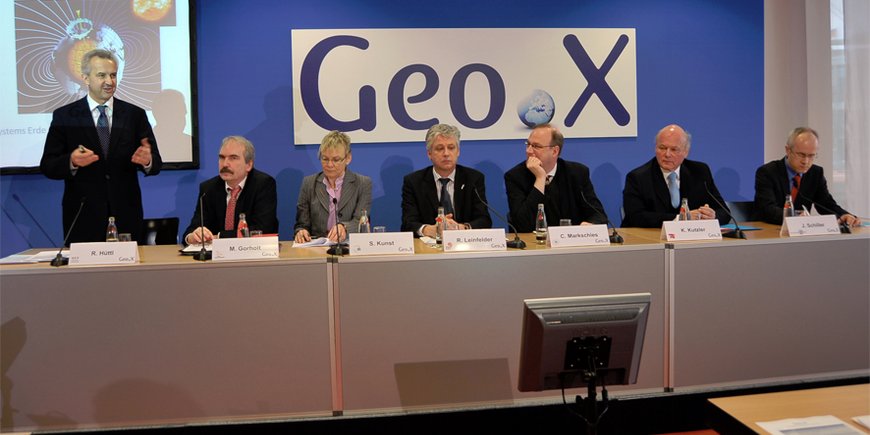Six Universities and Institutions create the Platform Geo.X
03.03.2010 | Potsdam: On Wednesday, 03 March 2010, the Humboldt University Berlin, the Free University Berlin, the Technical University Berlin, the Berlin Museum of Natural History, the University of Potsdam and the Helmholtz Centre Potsdam – GFZ German Research Centre for Geosciences founded the coordination platform Geo.X. The name Geo.X stands for the bridging of geosciences to further natural and engineering sciences, but also to humanities and social-science disciplines. Geoscientific themes, of significant importance for the future of society, will be researched in an interdisciplinary manner.
The key objective of Geo.X is the consolidation of the geoscientific competence in the region of Berlin-Brandenburg. More than 1600 people in the participating institutions are engaged with geoscientific themes, approximately 3000 future geoscientists are studying at the universities. The region of Berlin-Potsdam is already a world-wide recognised location for this discipline. With the grouping within the Geo.X platform this expertise will be lent additional value. The geoscientists in the region of Berlin-Brandenburg “have in the last years been able to make significant contributions”, explains Professor Juergen Zoellner, Senator for Education, Science and Research, Berlin in an opening greeting. “They could hereby rely on a partly European- and world-wide, unique material and methodical scientific spectrum”. Preserving of this spectrum, its trend-setting structure, and its further shaping is not only the duty and obligation of the geosciences itself, but also an important concern of Berlin’s science policy”. Under-Secretary of State, Martin Gorholt, of the Ministry for Science, Research, and Culture of the State of Brandenburg, stated: “The establishment of the coordination platform Geo.X is a not only an appropriate, but also a necessary step. In this way projects within the framework of the Excellence Initiative of the Federal Government or other large joint projects can be more easily realised. Geo.X will, therefore, strengthen the economic competitiveness of the metropolis region of Berlin-Brandenburg". Professor Reinhard Huettl, Chairman of the Board of the GFZ and designated speaker of Geo.X added: “In the field of geosciences in the Berlin-Potsdam region collaboration between universities and non-university research institutions is already well established through numerous joint appointments. Through the use of excellent infrastructure such as large computers, large-scale instrumentation and international observatories this cooperation is being further extended. The structural platform Geo.X opens new potential in research and teaching for solving the big geoscientific challenges such as climate change and scarcity of resources. Furthermore, other fields of knowledge from institutions within the region can be merged interdisciplinary. Thus, a European-wide, unique configuration of geoscientific research emphasising “System Earth – Man” occurs”.
Geo.X starts out with three key research themes: “Natural Hazards and Risks”, Natural Resources and Energy Materials” as well as “Human Habitat and Sustainability”. In view of a growth of the world population to more than nine billion people up to the year 2050, these are, not only from the geoscientific view point, the largest challenges world-wide; these tasks are important for the entire international community of states.
With their respective scientific profiles the Geo.X partner institutions complement each other ideally. While the Technical University brings in its core focus on modelling of geo-information systems and a multiplicity of engineering-scientific projects and cooperation partners, the geo-scientific portfolio is complemented with the topics impact research and extinction of species through the Berlin Museum of Natural History, a research museum of the Leibniz Association. Furthermore, the Berlin Museum of Natural History offers extraordinary possibilities for geoscientific educational work through it exhibitions. The Humboldt University Berlin with its research fields contributes significant expertise to geo-information management and to the thematic spectrum of physical geography, and provides a strong connection to legal sciences via its Centre for Disaster Law. The Free University Berlin and the University of Potsdam enrich Geo.X through their basic and application-oriented georesearch. Both universities additionally contribute already existing ties to biology, mathematics and physics. The GFZ German Research Centre for Geosciences covers, as a Helmholtz Centre, all disciplines of the geosciences and carries out Earth system research on all spatial and time scales, and contributes, in particular, its international network.
Geo.X builds on already existing collaboration in research and teaching between the participating research institutions. Five joint DFG-research groups and two priority research programmes, four joint projects supported by the Federal Ministry for Education and Research and over ten groups of new generation scientists with the participation of several Geo.X partners are proof of this. In addition a total of over 500 PhD students, who are doing their doctorate at the respective Geo.X institutions speaks for itself. During the last five years more than 350 million € could be procured for geoscientific research.
Illustrations and photos on Geo.X in printable form can be found under:








![[Translate to English:] Torsten Sachs in front of a climate station on a field](/fileadmin/_processed_/3/9/csm__TorstenSachs_bearbeitet_GS_4a1365ef84.jpeg)

![[Translate to English:] left image flood at the Ahrtal: image from above, several houses are flooded; left image:: Heidi Kreibich;](/fileadmin/_processed_/4/4/csm_Bild2_9af0130e9f.png)



![[Translate to English:] Start der Vega Rakete](/fileadmin/_processed_/6/4/csm_20231201-kachel_Vega-VV23-launch_ESA-CNES-Arianespace_706716b68c.jpeg)









![[Translate to English:] Poster exhibition at the Brandenburg Hydrogen Day at the GFZ, some participants in the foreground](/fileadmin/_processed_/6/5/csm_Erster_Brandenburgischer_Wasserstofftag_GFZ_402fcec95e.jpeg)
![[Translate to English:] Group picture of the participants](/fileadmin/_processed_/9/4/csm_20231108_CAWa-Workshop-Tashkent_Gruppenbild_99ea779d8a.jpeg)

![[Translate to English:] [Translate to English:] Hörsaal](/fileadmin/_processed_/e/6/csm_H%C3%B6rsal_e21ac645fb.jpeg)


![[Translate to English:] The Delegations in the Historic Library on the Telegrafenberg. In the back there are from left to right, the Dutch Ambassador for Germany, Ronald van Roeden, the Dutch Minister for Education, Culture and Science, Robbert Dijkgraaf and the scientific director of the GFZ, Susanne Buiter.](/fileadmin/_processed_/d/b/csm_Kachel-2_9eba4b4212.jpeg)

